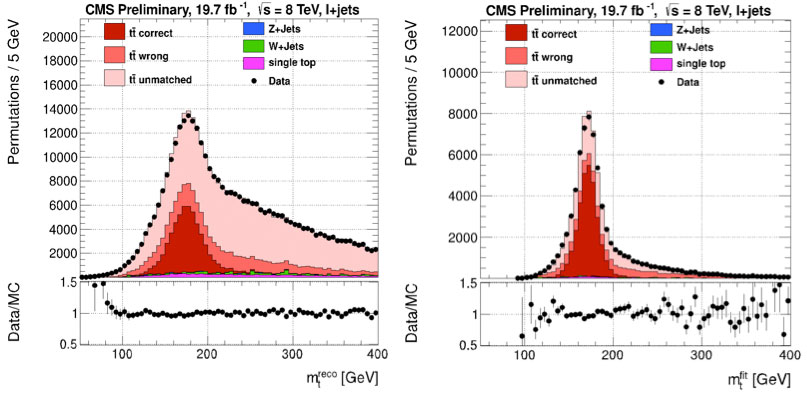
The new top-quark mass measurement is the single most precise result as yet.
The mass of the top quark, the heaviest known elementary particle to-date, is one of the fundamental parameters of the Standard Model. Although the top quark mass is already the best known mass of all quarks, the quest for precision persists, as the exact value of the top quark mass impacts directly on key predictions of the Standard Model: e.g. the production rates of top quarks at the LHC, the size of quantum corrections to electroweak processes, and not least the coupling strength of the top quark with the Higgs boson. Precise knowledge of the top quark mass is thus a cornerstone for the search for new physics which could manifest itself in small deviations from Standard Model predictions.
At the recent “Rencontres de Moriond” conference, the CMS collaboration presented a new improved mass measurement, which is based on the full LHC dataset recorded in the year 2012, corresponding to 80% of the data collected during Run I of the LHC. The new measurement yields a top quark mass mtop=172.04±0.19 (stat.+JSF)±0.75 (syst.) GeV [1], which alone is of the same precision as the recently published world average of the top-quark mass of mtop=173.34±0.76 GeV [2].
The new CMS analysis:
At the LHC, top quarks are predominantly produced in pairs, and each top quark subsequently decays to a W boson and a bottom quark. In the new analysis, CMS makes use of the complete dataset recorded in 2012, corresponding to an integrated luminosity of nearly 20 fb–1. Top quark pair events are selected in which one of the W bosons decays to an electron or a muon, accompanied by a neutrino, while the other W boson decays to a quark-antiquark pair forming jets. The experimental signature therefore comprises one lepton, four jets, two of which come from bottom quarks, as well as missing transverse momentum due to the undetected neutrino. A high-purity sample of more than 100 thousand top quark events is obtained by requiring the presence of two jets that originate from bottom quarks. To further improve the purity and the resolution for the top quark mass measurement, a kinematic fit to a top-quark pair event hypothesis is performed, and only events that match the expected top-quark event topology are retained. The remaining sample contains nearly 30 thousand events with a purity of more than 96%. The reconstructed invariant top quark mass distributions for events before and after the kinematic fit are shown in Figure 1.
From simulations of top-quark pair events for different top-quark mass assumptions, two-dimensional likelihood functions are derived that quantify how compatible a measured event is with a specific top-quark mass value and jet-energy calibration. In the likelihood fit, the measured invariant mass of the two jets associated with the W boson serves as an observable to estimate a residual jet-energy scale factor (JSF) from within the same data sample. Ultimate precision of the jet-energy calibration and the top-quark mass measurement is obtained by constraining the jet energies to match the expected W-boson mass, which is precisely known from previous measurements.
From the likelihood fit, the top-quark mass is measured to be mtop=172.04±0.19 (stat.+JSF)±0.75 (syst.) GeV. Dominant remaining uncertainties arise from systematic uncertainties on the correct modeling of the jet-energy resolution, on pile-up effects from overlap with other pp-collision events and on the jet-energy scale specific to jets containing bottom quarks.
A compilation of all measurements of the top quark mass by the CMS experiment is shown in Figure 2. Also shown in the figure is the combination of the new result with the previously published CMS measurements, yielding a value of 172.22±0.73 GeV. The new CMS result marks the start of a new era of LHC precision measurements of the top quark mass, which will lead to future updates of the world average.
Footnotes
[1] The CMS Collaboration, “Measurement of the top-quark mass in top-quark pair events with lepton+jets final states in pp collisions at sqrt(s)=8 TeV”, CMS Physics Analysis Summary TOP-14-001, https://cds.cern.ch/record/1690093?ln=en
[2] The ATLAS, CDF, CMS and D0 Collaborations, “First combination of Tevatron and LHC measurements of the top-quark mass”arXiv:1403.4427 [hep-ex]
- Log in to post comments

